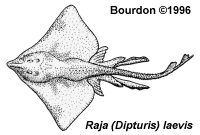| |
 The skates are circumglobal benthic batoids found in cooler waters -- shallow coastal to abyssal. In today's oceans, some 277 species (FishBase, Nov. 2007) are recognized, attributed to seven genera. In general, they lack a caudal spine, usually bear numerous thorns, and share a small number of similar tooth morphologies; sexual dimorphism is usually present. Under these circumstances, both the use of Raja as the correct genus and the reliability of fossil species based on a small group of teeth is problematic. In most cases, the website will continue to refer skate teeth to "Raja" to acknowledge its usage as a paleo-bucket and differentiate them from the extant Raja (sensu McEachran & Miyake 1990).
The skates are circumglobal benthic batoids found in cooler waters -- shallow coastal to abyssal. In today's oceans, some 277 species (FishBase, Nov. 2007) are recognized, attributed to seven genera. In general, they lack a caudal spine, usually bear numerous thorns, and share a small number of similar tooth morphologies; sexual dimorphism is usually present. Under these circumstances, both the use of Raja as the correct genus and the reliability of fossil species based on a small group of teeth is problematic. In most cases, the website will continue to refer skate teeth to "Raja" to acknowledge its usage as a paleo-bucket and differentiate them from the extant Raja (sensu McEachran & Miyake 1990).
 In broad terms, the dentition-designs may be crushing, clutching-crushing or clutching; the cuspidate teeth are usually associated with mature males. Each quadrate includes numerous files which may be independent / juxtaposed or imbricated / pavement-like (sensu Cappeta 1987 / Welton & Farish 1993: 14) in arrangement. The teeth are highly variable, but both crown faces are normally smooth and separated by a transverse edge which may extend along most of the labial face. The visor is strong and the uvula distinct (sensu Cappetta 1987: 20-21). The roots are high and bilobate; the lateral faces often include a apico-basal depression, the lobes tend to be splayed to some extent, and the groove includes a central pore(s) & is more opened labially.
In broad terms, the dentition-designs may be crushing, clutching-crushing or clutching; the cuspidate teeth are usually associated with mature males. Each quadrate includes numerous files which may be independent / juxtaposed or imbricated / pavement-like (sensu Cappeta 1987 / Welton & Farish 1993: 14) in arrangement. The teeth are highly variable, but both crown faces are normally smooth and separated by a transverse edge which may extend along most of the labial face. The visor is strong and the uvula distinct (sensu Cappetta 1987: 20-21). The roots are high and bilobate; the lateral faces often include a apico-basal depression, the lobes tend to be splayed to some extent, and the groove includes a central pore(s) & is more opened labially.
Many fossil species have been described and attributed to "Raja"; however many of these are problematic (Cappetta 1987: 143-44). Since the extant taxa tend to be regionalized, only North American reports will be included.
Late Cretaceous
Welton & Farish (1993: 137) included as Raja sp the single "Raja" tooth-design reported from the North American Cretaceous record. Case & Cappetta (1997: 147) went on to describe this design as R. farishi; it has been subsequently been reported from the Maastrichtian of Maryland (Hartstein et al., 1999) and Arkansas (Becker et al., 2006). This tooth-design has been collected by the author (fig. ) from the Late Cretaceous of North Carolina.
Personally, I'm neither convinced by the tooth-design nor the description that these teeth originate from a rajid -- for that reason, they will be included as "Raja".
Paleogene
To the author's knowledge, there is a single published record of "Raja" from either the Paleocene or Eocene of the western North Atlantic -- Ward & Wiest (1990: 85) included a single un-illustrated example from the Piscataway Mbr, Aquia Fm (Selandian-Thanetian) as ?Raja sp. This author has found a single specimen (Fig. ) from the basal Potapaco Mbr of the Nanjemoy Fm (Ypresian) of VA. Without corroborative specimens, it's difficult to determine if either originates from their respective horizons.
In the Oligocene the record tends to fill-out. Müller (2001:57-58, Fig. 18:7-10) reported a tooth-design he referred to as Raja sp 1 from the Ashley Fm of NC and the Old Church Fm of VA; the Old Church alone yields more than one "Raja" tooth-design (pers. obs.).
Neogene
Müller (2001:57-58) provides the most extensive published inventory of East Coast Neogene rajids; including one from the Miocene and four from the Pliocene.
Müller's Raja sp 2 (Fig. 18:14-17, Plate 12:4-5) is reported from the Calvert & St Marys Fms of Maryland (Miocene). The below Lee Creek specimen (fig. ) is an example of this tooth-design. Figure represents another Miocene tooth-design known from Calvert, St. Marys and Pungo River (fig ) Formations. Additional 'Raja' tooth-designs are present in the Pungo River (pers. obs.).
Müller's Raja spp 3-6 were all reported from the Yorktown (Pliocene) at Lee Creek. Figure depicts his Raja sp 5 design (Fig. 18: 18-19 Plate 13: 1-2) and figure likely represents a positional or sexual variation of this design. Other Pliocene tooth-designs were not fully figured, so it would be highly speculative to map to them to particular specimens. There is no reason to question the presence of two or three more "Raja" species.
Purdy et al (2001: 89-90 fig 9) reported a single taxon, Raja sp, from the Yorktown at Lee Creek; their figures 9c & d compare well with Figure and 9a & b with Figure .
Given sufficient extant East Coast comparative material, disassembled specimens would likely provide the evidence to identify the Yorktown and some of these Miocene skates.
Selected References
Becker, M, Chamberlain, J and Wolf, G., 2006. Chondrichthyans from the Arkadelphia Formation (Upper Cretaceous: Upper Maastrichtian) of Hot Spring County, Arkansas. Journal of Paleontology; 80:4; pp 700-716.
Cappetta, H., 1987. Chondrichthyes II. Mesozoic and Cenozoic Elasmobranchii. In: Handbook of Paleoichthyologie, vol. 3b, Gustav Fischer Verleg, Stuttgart, 193 pp.
Case, G. and Cappetta, H.. 1997. A new selachian fauna from the late Maastrichtian of Texas. Münchener Geowissenschaften Abhandungen 34:131-189.
Hartstein, E., Decina, L. and Keil, R., 1999. A Late Cretaceous (Severn Formation) Vertebrate Assemblage from Bowie, Maryland. The Mosasaur, VI:17-23.
Herman, J., Hovestadt-Euler, M. and Hovestadt, D., 1994 - 1996. Part B: Batomorphii No. 1a b, c Order Rajiformes - Suborder Rajoidei - Family:Rajidae. Contributions to the study of the comparative morphology of teeth and other relevant ichthyodorulites in living supraspecific taxa of chondrichthyan fishes. Bulletin de L'Institut Royal des Sciences Naturelles de Belgique, Biologie: 64: 165-207, 65: 237-307 and volume 66: 179-236.
McEachran, J. and Miyake 1990. Phylogenetic Interrelationships of Skates: A Working Hypothesis pp 285-304. Elasmobranchs as Living Resorces: Advances in the Biology, Ecology, Systematics, and Status of the Fisheries, H. L. Pratt, S. H. Gruber, T. Taniuchi (eds.). NOAA Technical Report NMFS 90. U.S. Department of Commerce.
Muller, A. 1999. Ichthyofaunen aus dem atlantischen Tertiär der USA. Leipziger Geowissenschafteb, Leipzig, 9/10: 1-360.
Purdy, R., Schneider, V., Appelgate, S., McLellan, J., Meyer, R. & Slaughter, R., 2001. The Neogene Sharks, Rays, and Bony Fishes from Lee Creek Mine, Aurora, North Carolina. In: Geology and Paleontology of the Lee Creek Mine, North Carolina, III. C. E. Ray & D. J. Bohaska eds. Smithsonian Contributions to Paleobiology, No 90. Smithsonian Institution Press, Washington D.C. pp. 71-202.
Ward, D. J. and Wiest, R.L., 1990. A checklist of Paleocene and Eocene sharks and rays (Chondrichthyes) from the Pamunkey Group, Maryland and Virginia, USA. Tertiary Res., 12(2) p 81-88.
Welton, B. and Farish, R., 1993. The Collector's Guide to Fossil Sharks and Rays from the Cretaceous of Texas. Before Time, Texas. 204 pp.
|